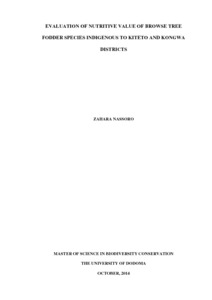Evaluation of nutritive value of browse tree fodder species indigenous to Kiteto and Kongwa Districts
Abstract
The use of browse tree fodder as supplements to ruminant feeding in the tropics is limited by lack of information on their nutritive potential. A study was carried out to screen eight browse species in Kongwa and Kiteto districts (Acacia mellifera, Acacia senegal, Acacia xanthophloea, Acacia tortilis, Boscia spp., Gliricidia sepium, Leucaena pallida and Melia azedarach) for potential chemical composition, concentration of minerals, and in vitro digestibility potential using chemical assays. Data analysis was done by using SAS (9.1.3) software. Results reveal that the browse tree species had high levels of crude protein (CP) that varied (P<0.05) among the species from 130-230 g/kg DM for A. xanthophloea and G. sepium respectively. The species had moderate to low (P<0.05) contents of fibers which varied among the species. NDF ranged from 342 (Acacia xanthophloea) to 644 g/kg DM (Boscia spp.), ADF 184 g/kg DM (L. pallida) to 577 g/kg DM (M. azedarach) and ADL ranged from 38-175 g/kg DM. The browse species had sufficient contents of macro minerals which varied (P<0.05) among the species from (2.2-12.6, 1.8-7.1, 1.4-6.4 and 1.5-3.1) g/kg DM for Ca, P, Mg and S respectively. Concentrations of micro minerals among the species were moderate to high (P<0.05) which varied from (4.3-53, 155-300, 13.1-80.9 and 15.2-46) mg/kg DM for Cu, Fe, Mn and Zn, respectively. The species had high (P<0.05) in vitro digestibility potential that varied from 320-671 g/kg DM and 325-658 g/kg DM for IVOMD and IVDMD, respectively. The browse tree fodder species in the current study could be utilized as protein supplements to ruminant livestock fed on low quality feeds including hays, stovers and crop residues due to their high levels of crude protein and minerals, low fiber contents as well as high digestibility potential.

